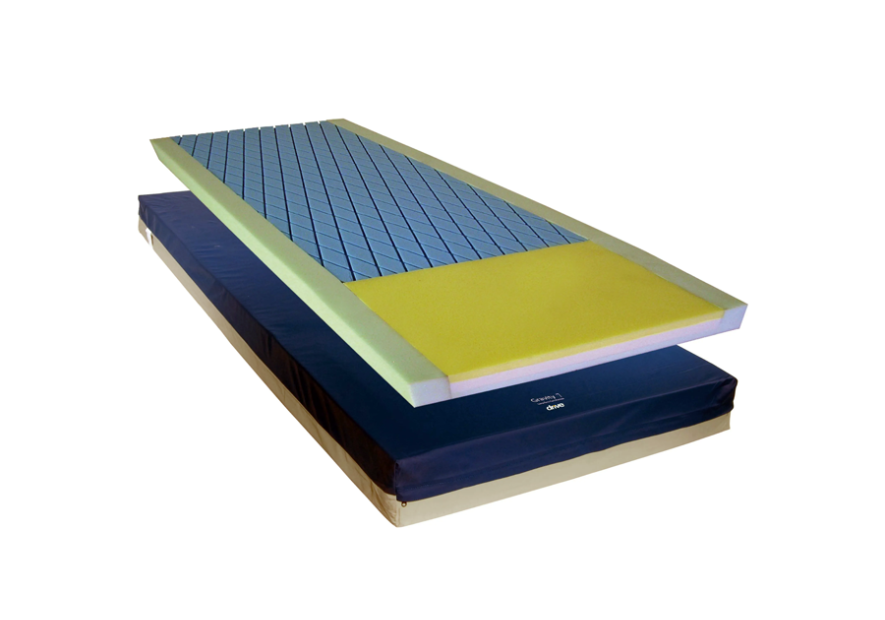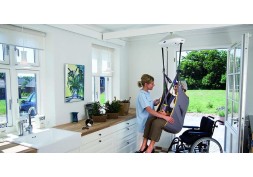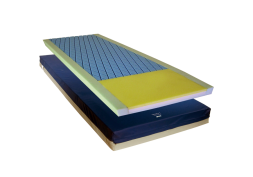The difference between dynamic airflow and static foam mattresses

This article will help you to understand the differences between dynamic airflow and static foam pressure care mattresses and will assist with determining the best type of equipment to use when assessing a patient's individual requirements.
Airflow mattresses and static foam mattresses are both types of pressure care mattresses, but they differ significantly in their design, construction, and functionality. Here are the key differences between the two:
Construction and Materials:
Airflow Mattresses: These mattresses use air-filled chambers or cells to provide support and pressure redistribution. The air chambers are either interconnected or operate independently, and the pressure within the cells can be adjusted based on the user's needs. Some airflow mattresses also incorporate low air loss technology, which allows a controlled flow of air to help keep the skin dry and reduce moisture-related skin breakdown.
Static Foam Mattresses: Static foam mattresses are made from various types of foam, such as memory foam, polyurethane foam, or high-resilience foam. These mattresses do not contain air chambers and maintain a consistent, unchanging surface throughout use.
Pressure Redistribution:
Airflow Mattresses: The adjustable air chambers in airflow mattresses allow for dynamic pressure redistribution. The pressure can be periodically changed to different areas of the body, reducing the risk of prolonged pressure on any specific point. This dynamic pressure relief can be beneficial for individuals with limited mobility or those at a high risk of developing pressure ulcers.
Static Foam Mattresses: Static foam mattresses offer passive pressure redistribution. The foam material conforms to the shape of the body, spreading the weight evenly across the surface. However, once the person settles into a position, the pressure remains constant until they change positions manually.
Risk of Pressure Ulcers:
Airflow Mattresses: Due to their dynamic pressure redistribution capabilities, airflow mattresses are generally considered more effective in preventing pressure ulcers, especially for individuals who spend extended periods in bed or have compromised mobility.
Static Foam Mattresses: Static foam mattresses provide pressure relief, but they may not be as effective as airflow mattresses in preventing pressure ulcers for individuals at high risk.
Cost and Maintenance:
Airflow Mattresses: Airflow mattresses, especially those with advanced features like low air loss technology, tend to be more expensive than static foam mattresses. Additionally, they may require regular maintenance to ensure the proper functioning of the air chambers and air pumps.
Static Foam Mattresses: Static foam mattresses are often more affordable and require minimal maintenance since they do not have any mechanical components.
Noise and Power Usage:
Airflow Mattresses: Some airflow mattresses may produce noise due to the air pump's operation, which could be a consideration for noise-sensitive environments. Additionally, airflow mattresses require electricity to power the air pump.
Static Foam Mattresses: Static foam mattresses are completely silent and do not require any power source to function.
In summary, airflow mattresses and static foam mattresses have different designs and functionalities. Airflow mattresses offer dynamic pressure redistribution through adjustable air chambers, making them more effective in preventing pressure ulcers for at-risk individuals. On the other hand, static foam mattresses provide passive pressure relief, are more affordable, and require less maintenance. The choice between the two depends on the individual's specific needs, risk profile, and budget considerations. Healthcare professionals typically assess the patient's condition and risk factors to determine the most appropriate pressure care mattress for their unique requirements.


